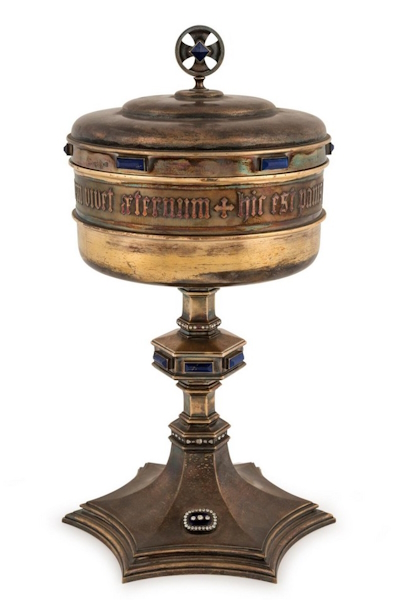Anyone looking silver, porcelain, glass or crystal, clocks, furniture, rugs, lamps, tribal artefacts, paintings, religious icons, jewellery, watches, cameras, radios, maps or posters will no doubt will find what they are after.
Most of the auction items are very affordable with catalogue estimates in the hundreds of dollars range.
However, a significant number are collector pieces beginning with the opening lot, a circa 1900 French gilded silver chalice complete with the inscription “Whoever Eats Of This Bread, He Shall Live Forever” by French silversmith Paul Brunet who worked around Paris in the second half of the 19th century.
Ancient Chinese pottery is in this category including two items from the Tang Dynasty (618 to 907 A.D.) – a camel statue (Lot 574 ) and statue of a male figure with a ball (Lot 575 ), each accompanied by thermoluminescence test certificates from Oxford Authenticity and carrying respective estimates of $8000-$10,000 and $7500-$10,000.
A pre-Columbian Mayan orange ware pottery cylinder vessel from the late Classic Period of 550-950 A.D. (Lot 578 ) is another ancient attraction, while a 14th-15th century north Indian Lakshimi bronze statue with the remains of a cold painted finish and inlaid with gemstones (Lot 581 ) is worth a second look.
Collectors also should be interested in an Egyptian carved stone hippopotamus believed to bring good luck and protection, identified with the goddess Taweret, from the Middle Kingdom 2100-1800 B.C. (Lot 576 ).
Amongst the tribal artefacts on offer is a particularly fine 19th century Fijian chieftain’s whale tooth necklace known as a Wasekaseka (Lot 566 ), acquired in New Zealand and restrung in the late 1960s.
Paintings in the auction are from Australia and Europe and include 19th century work from an unknown artist featuring Dutch men of war at harbour (lot 594) and lot 595, a circa 1770s oil entitled A Meeting on a Woodland Path by Italian artist Francesco Casanova (1727-1802).
Another work entitled The Book Seller (lot 612) is by French artist Gustave David (1824-1891).
The militaria range is fascinating and features a 20th century replica suit of Middle Ages armour (Lot 764 ), a circa 1830s pair of antique flintlock pistols of Ottoman Balkans origin (Lot 766 ) and a circa 1907-1918 Saxon Guard cavalry regiment officer’s parade lion helmet (Lot 778 ) with a catalogue estimate of $12,000-$15,000.
There is a comprehensive range of jewellery including an intricate Spanish art nouveau 18-carat gold brooch with enamel floral decoration (Lot 1074 ) from Barcelona’s Masriera jewellery workshop that boasts a long history of fine craftsmanship stretching back to the 19th century. This piece is believed to be the work of Llius Masriera (1872-1958).
The furniture also is impressive with a 19th century antique ebonised mahogany American Wooton desk with incised gilt decoration (Lot 423 ) of particular note.
